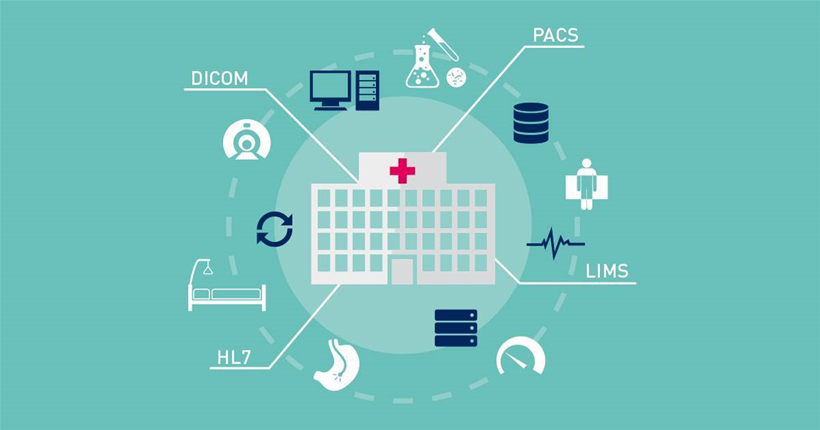Doctors’ expectations of their access to comprehensive patient data are changing with the advent of digitalisation. The goal is to put all necessary patient data and information at the doctor’s disposal for a medical examination, starting with the patient’s personal data, then patient history, X-rays and laboratory results.
Reality paints a different picture: Until now, the different systems in the hospital have been mostly standalone solutions. Systems such as imaging devices, image archiving systems, and communications and information systems are in the hands of a handful of specialist departments.
Communications server as a general interface
In order for all possible information to converge in the IT department in the future, a mutual interface — a communications server — is needed. The aforementioned self-sufficient medical systems use a special protocol to communicate with the communications server, which forwards the collected data to the doctor’s terminal device.
To ensure the availability of these systems, comprehensive monitoring of both IT and medical devices is required.
Ideally, this monitoring should already be taking place. The IT department monitors your system environment, and the medical specialist departments monitor their devices. Now if the doctor happens to be missing something, such as an X-ray image during a medical examination, then a lengthy troubleshooting process begins.
The doctor may first ask the IT manager if there are problems with data transmission. In response, the IT manager will check the monitoring system and if no errors are detected refer the doctor to the X-ray machine manager.
The X-ray may not find any errors either and refer the doctor to the manager for the communications server. After that manager has certified that their systems also work flawlessly, the doctor then speaks with the manager of the image archiving system, who diagnoses an irregularity and begins the troubleshooting process.

via support for DICOM and HL7 in the same way it integrates
the communications server via the Rest API.
Comprehensive network and device monitoring
This path from the problem to the solution — which was admittedly presented in a somewhat exaggerated fashion — can always be simplified by introducing a system for monitoring the entire infrastructure.
Seamless and comprehensive monitoring of networks and work devices is indispensable with the growing interconnectedness of devices and services in the healthcare industry.
This poses a special challenge for providers of monitoring solutions, since a crucial part of communication between medical devices does not take place through conventional network protocols, whereas communications in typical IT networks is carried out via protocols such as SNMP or WMI, information from medical devices in hospitals is mainly exchanged via DICOM or HL7.
The central communications server builds the bridge between the classic network infrastructure and the healthcare network. It accesses many different information systems via interfaces – for example, it prepares data from radiology information systems (RIS), hospital information systems (HIS), laboratory information systems (LIMS) and the picture archiving and communications systems (PACS) and provides the data.
These communication channels can also be used to query the various system statuses of the connected devices, making proactive monitoring possible in the first place through a central system.
Predicting maintenance cycles
In practice, this results in a multitude of practical applications. In addition to the typical monitoring of system statuses, predictive maintenance can also be performed on high-maintenance devices. This process, mainly used in Industry 4.0 to date, uses the measurements and data from sensors and calculates the ideal time for device maintenance, thereby minimising downtimes.
In addition to the ideal option of planning the maintenance of clinical devices in advance, typical network problems can also be proactively monitored. As a result, communication problems between the X-ray machine and its image data archiving system can be displayed as transparently as connection problems between the PC and printer.
Paessler AG has set itself the task of combining this de facto communications standard in the healthcare sector with an IT monitoring solution and thus ensuring seamless, comprehensive monitoring of the internet of things. The PRTG Network Monitor monitoring software already supports the DICOM and HL7 protocols; communication servers can be integrated via the Rest API. As such, PRTG is able to monitor nearly any hospital infrastructure that is capable of communicating.







